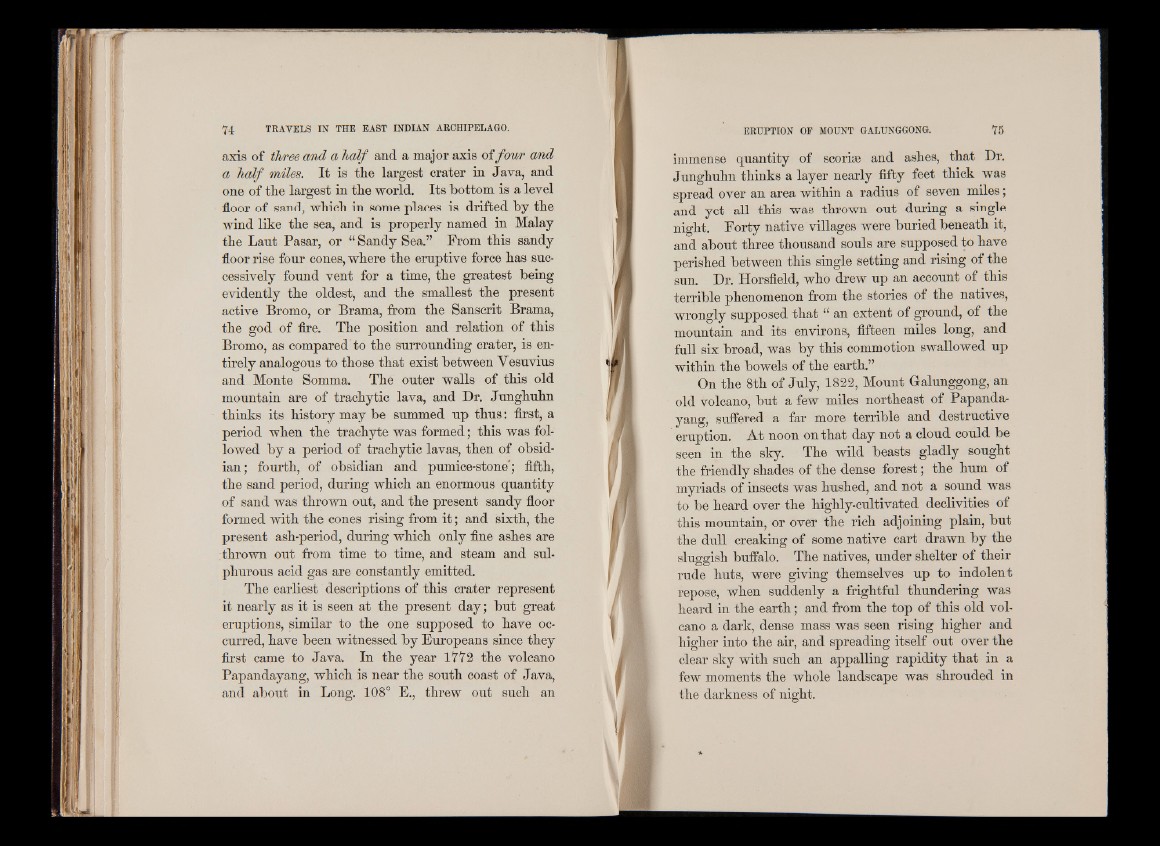
axis of three <md a half and a major axis of fo u r and
a h alf miles. It is the largest crater in Java, and
one of the largest in the world. Its bottom is a level
floor of sand, which in some places is drifted by the
wind like the sea, and is properly named in Malay
the Lant Pasar, or “ Sandy Sea.” From this sandy
floor rise four cones, where the eruptive force has successively
found vent for a time, the greatest being
evidently the oldest, and the smallest the present
active Bromo, or Brama, from the Sanscrit Brama,
the god of fire. The position and relation of this
Bromo, as compared to the surrounding crater, is entirely
analogous to those that exist between Vesuvius
and Monte Somma. The outer walls of this old
mountain are of trachytic lava, and Dr. Junghuhn
thinks its history may be summed up thus: first, a
period when the trachyte was formed; this was followed
by a period of trachytic lavas, then of obsidian;
fourth, of obsidian and pumice-stone*; fifth,
the sand period, during which an enormous quantity
of sand was thrown out, and the present sandy floor
formed with the cones rising from i t ; and sixth, the
present ash-period, during which only fine ashes are
; thrown out from time to time, and steam and sulphurous
acid gas are constantly emitted.
The earliest descriptions of this crater represent
it nearly as it is seen at the present day; but great
eruptions, similar to the one supposed to have occurred,
have been witnessed by Europeans since they
first came to Java. In the year 1772 the volcano
Papandayang, which is near the south coast of Java,
and about in Long. 108° E., threw out such an
immense quantity of scoriae and ashes, that Dr.
Junghuhn thinks a layer nearly fifty feet thick was
spread over an area within a radius of seven miles;
and yet all this was thrown out during a single
night. Forty native villages were buried beneath it,
and about three thousand souls are supposed to have
perished between this single setting and rising of the
sun. Dr. Horsfield, who drew up an account of this
terrible phenomenon from the stories of the natives,
wrongly supposed that “ an extent of ground, of the
mountain and its environs, fifteen miles long, and
fall six broad, was by this commotion swallowed up
within the bowels of the earth.”
On the 8th of July, 1822, Mount Galunggong, an
old volcano, but a few miles northeast of Papandayang,
suffered a far more terrible and destructive
eruption. At noon on that day not a cloud could be
seen in the sky. The wild beasts gladly sought
the friendly shades of the dense forest; the hum of
myriads of insects was hushed, and not a sound was
to be heard over the highly-cultivated declivities of
this mountain, or over the rich adjoining plain, but
the dull creaking of some native cart drawn by the
sluggish buffalo. The natives, under shelter of their
rude huts, were giving themselves up to indolent
repose, when suddenly a frightful thundering was
heard in the earth; and from the top of this old volcano
a dark, dense mass was seen rising higher and
higher into the air, and spreading itself out over the
clear sky with such an appalling rapidity that in a
few moments the whole landscape was shrouded in
the darkness of night.